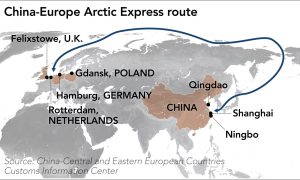The Istanbul Bridge, a Chinese-owned Panamax container ship, just pulled off what many in the Pentagon used to call “science fiction.” It sailed from China to the UK — through the Arctic — and docked at Felixstowe on Oct. 13 after a 20-day run. That’s not a typo. That’s a full-blown, real-world Arctic transit, now logged in the books.
Compare that to the traditional slog through the Suez Canal: 11,000 nautical miles and 40 to 50 days, depending on traffic, weather, and how many bribes you need to slip the canal authorities. The Arctic route? 7,500 miles and 20 days. The math isn’t fuzzy — it’s brutal. A direct savings in time, fuel, crew costs, and risk. That’s what global shippers care about.
But this isn’t about cheaper cargo. It’s about power. Territory. Influence.
And in this game, the U.S. is behind.
The Chinese Just Made a Statement
 Let’s break this down without the State Department polish. The Istanbul Bridge voyage was the first cargo-type service through the Northern Sea Route (NSR) — the stretch of Arctic waters hugging Russia’s northern coast. That means it wasn’t a one-off science vessel or a naval trial balloon. This was commercial trade between Asia and Europe, with scheduled port calls and a working supply chain.
Let’s break this down without the State Department polish. The Istanbul Bridge voyage was the first cargo-type service through the Northern Sea Route (NSR) — the stretch of Arctic waters hugging Russia’s northern coast. That means it wasn’t a one-off science vessel or a naval trial balloon. This was commercial trade between Asia and Europe, with scheduled port calls and a working supply chain.
That’s a line in the ice.
And it says: China is open for Arctic business.
Yes, technically, the ship used international waters. But don’t kid yourself — most of the NSR runs through waters Russia claims as under its jurisdiction, and they enforce it. All foreign vessels must get Russian approval, and they’re escorted by Russian nuclear-powered icebreakers — for a fee. That’s soft power, hardwired into maritime logistics.
Now plug in China. Beijing has been cozying up to Moscow for years on Arctic cooperation. China’s official stance? They’re a “Near-Arctic State” — a made-up term, but one they repeat like gospel. And this voyage shows they’re not waiting for permission from Washington or Brussels to make it a reality.
The U.S. Fleet Is Not Ready
The United States, meanwhile, is still patrolling the Arctic with two heavy icebreakers, one of which — the Polar Star — is older than most of the sailors serving aboard her. If she were an F-4 Phantom, she’d be in a museum, not steaming through the Chukchi Sea.
We’ve known this was coming. GAO reports have been screaming about the “icebreaker gap” for years. Congress holds hearings. The Navy files studies. Coast Guard brass puts on a good face. But the enemy — time — keeps moving.
Just this month, the U.S. signed a Memorandum of Understanding with Finland to build up to 11 icebreakers, starting there and eventually moving production stateside. Good. But right now, that’s just an MOU. No ship has been laid down. No contract signed. No steel cut. And it’ll be years before those hulls hit water.
In the meantime, China and Russia are already carving lanes in the Arctic — backed by nuclear-powered icebreakers, deepwater ports, and telecom cables under the ice. That’s logistics. That’s influence. That’s control.
Strategic Implications
Let’s call it what it is:
-
The Arctic is a new global shipping route
-
It is faster, cheaper, and less vulnerable to chokepoints like the Suez or Panama Canals
-
It is mostly under Russian influence, and increasingly under Chinese commercial interest
The Pentagon calls this a “domain.” Fine. But domains mean nothing if you can’t operate in them. Right now, we can’t — not for long, not without Russian help, and not without breaking ice like amateurs.
In war or peace, whoever controls the logistics corridor controls the outcome. The Northern Sea Route is becoming a corridor — not just for ships, but for leverage.
The Bottom Line
We can wave flags all day about “Freedom of Navigation,” but it’s cold steel in the water that counts. The Istanbul Bridge made it through first. Others will follow. If we don’t move faster — with icebreakers, presence, and real investment — we’ll be watching from the sidelines as our rivals write the Arctic’s shipping rules.
